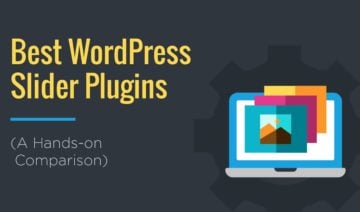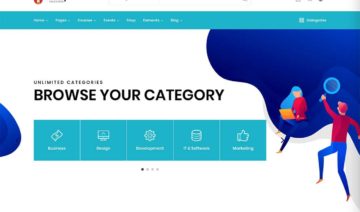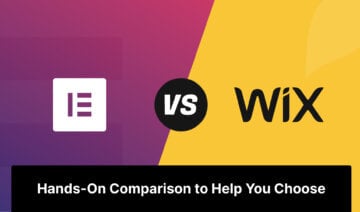Trying to choose between LearnDash vs LifterLMS to create and sell online courses with WordPress?
These are two of the best and most popular WordPress LMS plugins, so you won’t make a horrible decision with either. However, there are some important features and pricing differences between the two that might push you in one direction or another.
In our hands-on LifterLMS vs LearnDash comparison, I’ll try to help you uncover those important differences by comparing each plugin in detail. Here’s what I’ll compare in detail:
- High-level feature lists.
- The course builder for lessons, quizzes, etc.
- How each plugin lets you charge for access to your courses.
- Pricing and how there can be huge pricing differences depending on your needs.
There’s a lot to cover, so let’s dig in.
Features
To kick off our LearnDash vs LifterLMS comparison, here’s a quick rundown of some of the high-level features that each platform offers.
| Feature | LearnDash | LifterLMS |
| Free version | ❌ | ✅ |
| Drag-and-drop course builder | ✅ | ✅ |
| Video lessons | ✅ | ✅ |
| Quizzes | ✅ | ✅ |
| Content dripping | ✅ | ✅ |
| Assignments | ✅ | ✅ |
| Certificates | ✅ | ✅ |
| One-time payments | ✅ | ✅ |
| Recurring payments | ✅ | ✅ |
| Course bundles | ✅ | ✅ |
| Group access | ✅ | ✅ |
Basically, my goal with this table is to show you that both LearnDash and LifterLMS have all of the features that most people will need.
However, there are obviously smaller differences that might apply to your specific needs, so you’ll want to look closely at each feature.
For example, while both let you create quizzes, they each have different lists when it comes to the types of quiz questions that you can ask. Comparing all of these smaller feature differences would take a book, so you’ll need to dig in yourself if you have specific needs.
But in terms of the high-level stuff, you won’t notice huge differences either way for the average use case.
Course Builder
Both LifterLMS and LearnDash give you drag-and-drop course builders to create and manage your content. In general, I find both builders to be user-friendly and efficient for course creation.
Overall, I would give a slight edge to LifterLMS because it manages to give you more settings from a single unified interface. That is, with LifterLMS, you’ll have fewer situations where you need to open a new tab to change something, which makes for a more streamlined creation/management experience.
However, both are excellent builders, and I think you’ll be happy with either. Both also don’t require any technical knowledge — you should have no problems creating courses even if you’re a non-technical user.
LearnDash Course Builder
When you create a course in LearnDash, you’ll work within the normal WordPress block editor…but with some additions at the top of the page:
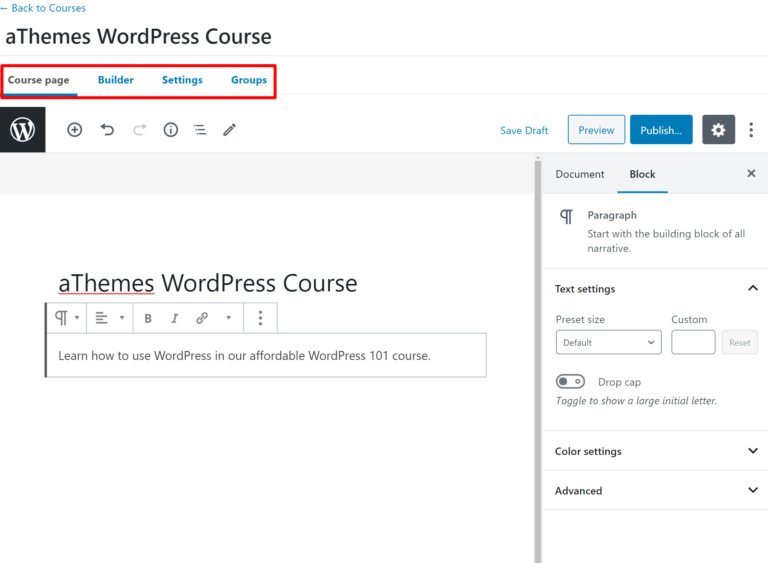
To create the structure for your course, you can go to the Builder tab. There, you can divide your courses with section headings and use lessons to add content.
LearnDash also adds a third hierarchy — topics. Topics let you further subdivide your lessons into different sections. Topics are optional; some course makers will just use section headings and lessons. But topics are a nice feature to add if you have a lot of content and want to break your lessons down into more bite-sized chunks.
LearnDash will clearly mark lessons with a green “L” and topics with an orange “T”. You can also add quizzes, which will be marked with a “Q”:
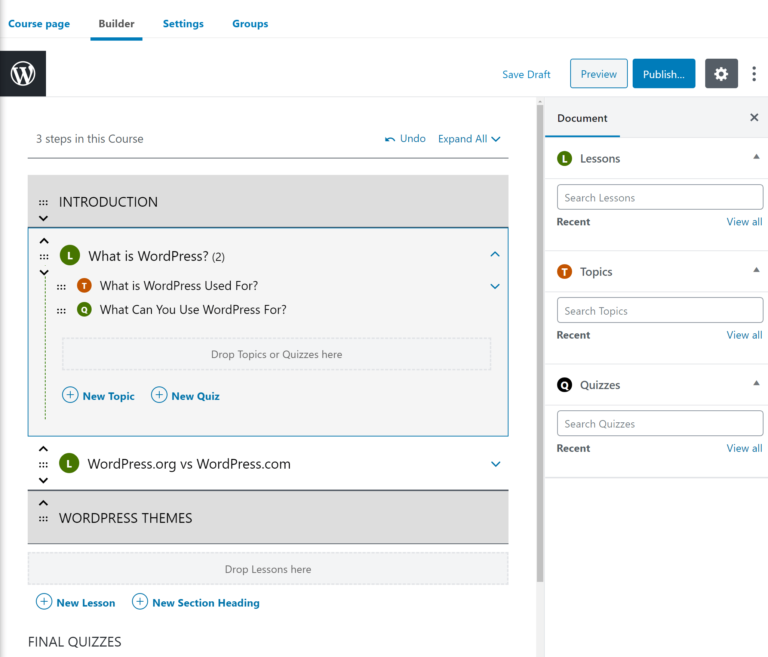
Rearranging any type of content is easy. You just use drag-and-drop to move the content where you want it to be within the overall structure of your course.
Overall, I find this bird’s eye view to be very intuitive for laying out the structure of the courses. It’s easy to see how everything comes together.
LearnDash Lesson Builder
To edit an individual lesson (or quiz), you’ll need to open a separate interface, which you can do right from the course builder by clicking an icon.
In the lesson builder page, you’ll be able to add content using the regular WordPress block editor.
One thing I like is that LearnDash includes some boxes in the lesson editor to help you see where the lesson fits into the overall course and also go back to the main course builder page:
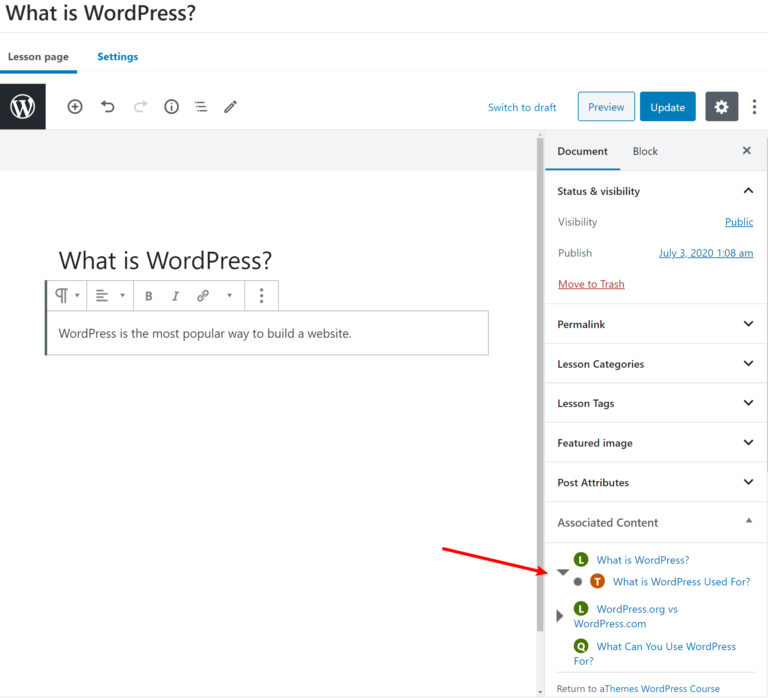
In the lesson settings tab, you can configure some useful settings including:
- Adding a video that learners must watch as part of the course progression.
- Adding a drip content schedule for when the lesson should be available. For example, if you want to drip content, you could make the lesson available seven days after a user enrolls in the course. This is especially useful for recurring courses as it lets you prevent people from binging course content.
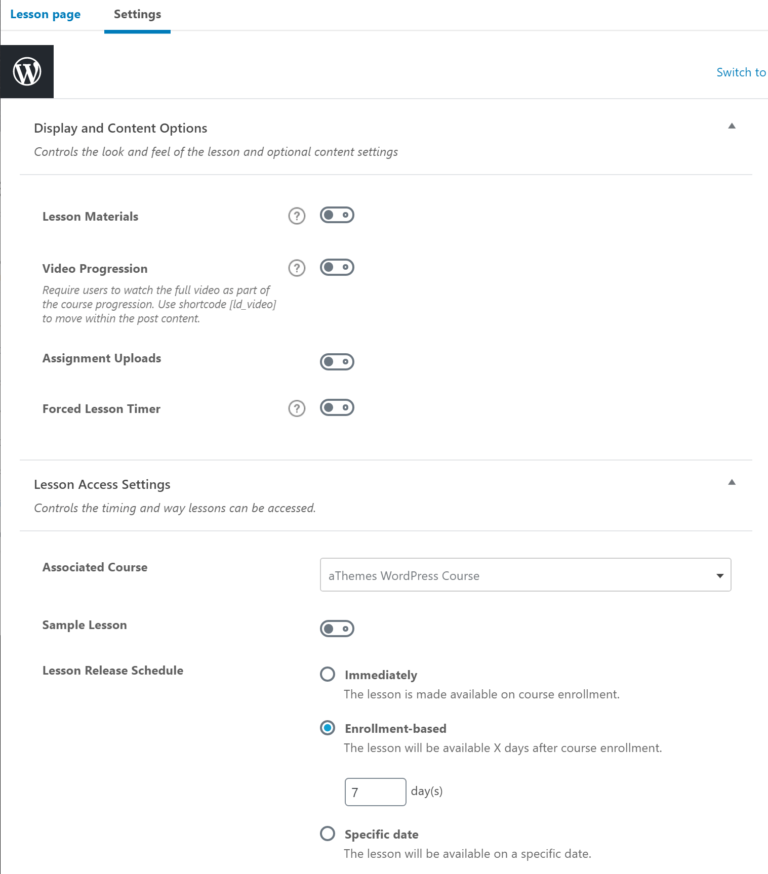
The topic editor is basically the same as the lesson editor. However, you can’t drip out individual topics — you can only drip lessons (and all of the topics inside the lesson).
LearnDash Quiz Builder
The quiz builder is a lot like the course builder. First, you get the regular WordPress block editor where you can add basic content for your quiz, such as some introduction text. Then, you can go to the Builder tab to create your quiz layout using drag-and-drop.
You can first add your high-level questions. LearnDash will mark them with a red warning icon at first to indicate that you haven’t fully configured the question.
To configure a question, you can open its settings to:
- Choose which type of question it is.
- Add answer choices (if applicable).
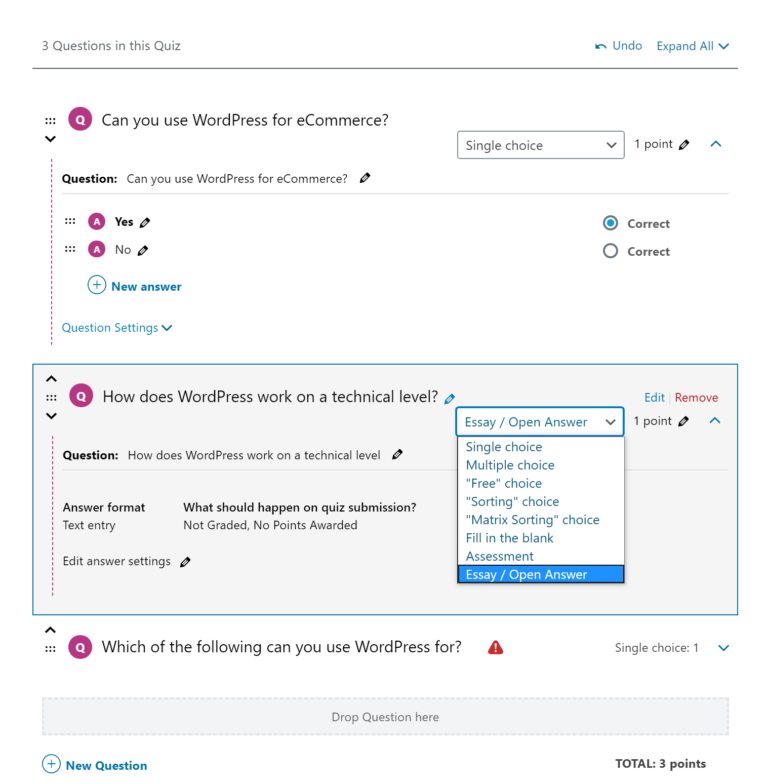
You get the following types of questions:
- Single choice
- Multiple choice
- “Free” choice
- “Sorting” choice
- “Matrix sorting” choice
- Fill in the blank
- Assessment
- Essay/Open Answer
In the overall quiz settings, you can configure additional settings such as:
- What a passing score is.
- Whether people can retake the quiz and, if so, how many times.
- Adding a certificate for completing the quiz.
- Setting a time limit.
LifterLMS Course Builder
At a high level, LifterLMS does things similarly to LearnDash in that it also offers a drag-and-drop course builder. However, there are a few smaller differences in the details.
First, you’ll add basic course information using the block editor. You can also configure some basic details, such as the course length, difficulty level, and a featured introduction video.
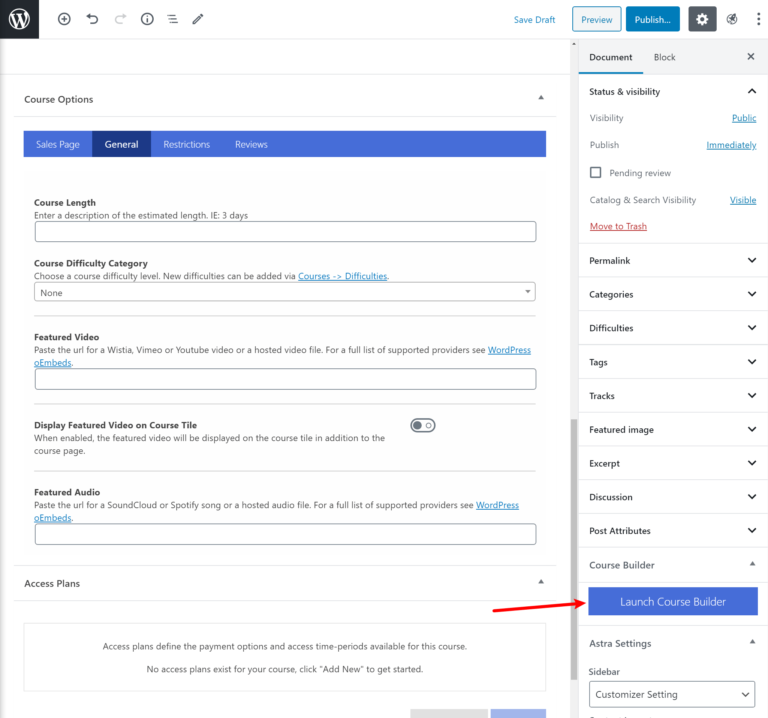
Then, you can launch the course builder by clicking the button.
The course builder takes up the full screen. You get two levels:
- Sections
- Lessons
LifterLMS doesn’t include a “topic” level like LearnDash, but I don’t think that will make a difference for most people.
Again, one of the things that I really like about LifterLMS is how it tries to include as much information as possible in the course builder.
For example, using the icons below each lesson, you can quickly see:
- Whether it has any text content.
- Whether it has any audio or video content yet.
- Who can see the lesson.
- Whether or not it’s scheduled to be dripped out.
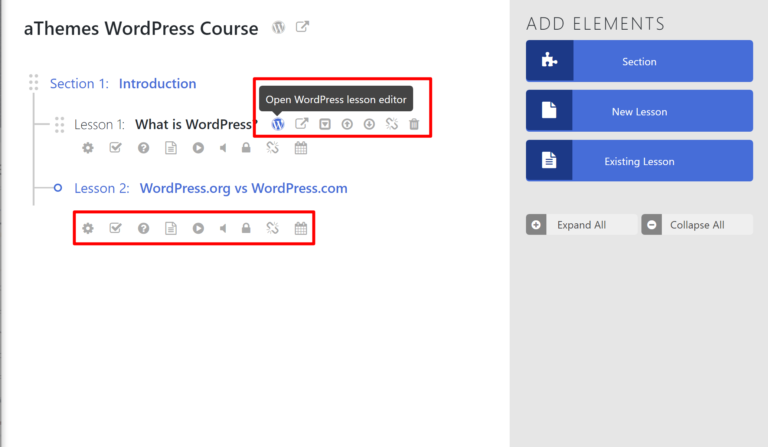
There are a lot of icons to learn. But once you learn them, they make it really easy to quickly see where you’re at with each lesson.
In addition to the icons, you also get to edit some important settings without leaving the course builder. For example, you can:
- Add video or audio embeds.
- Control the drip schedule.
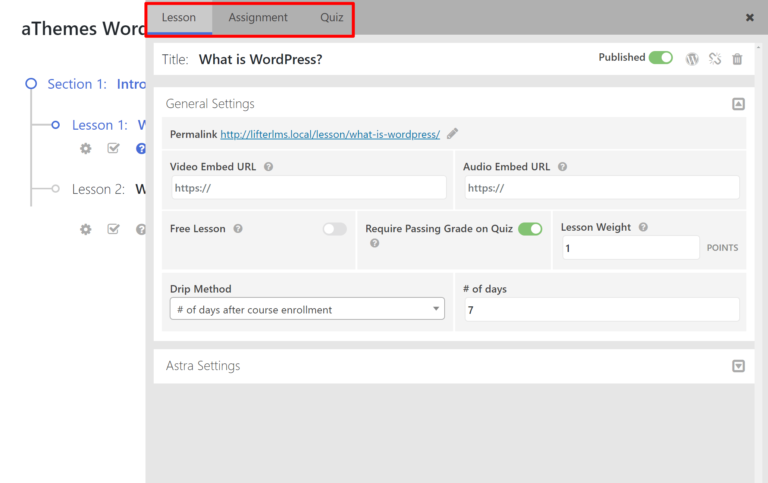
You’ll also be able to control quizzes from the main course builder page, but more on that later.
LifterLMS Lesson Builder
While you can add video and audio embeds without leaving the course builder, you do need to open a new tab to add other lesson content (such as text content).
Like LearnDash, you can use the regular block editor where you’ll also get a box that shows you where you’re at in the overall structure of your course:
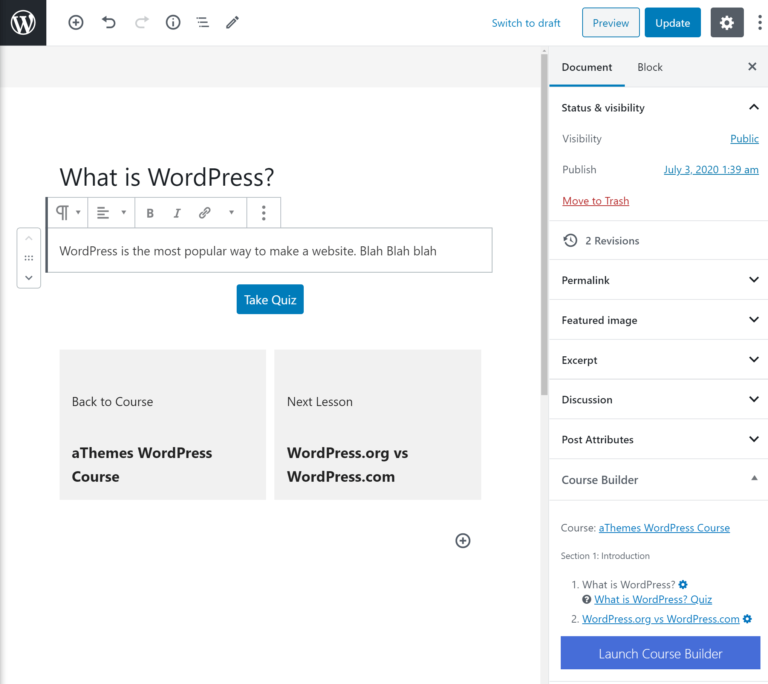
At the bottom, you can configure some additional settings, most of which are also editable from the main course builder, for example, drip settings.
LifterLMS Quiz Builder
Again, LifterLMS lets you create quizzes without leaving the course builder, which I find to be very convenient.
First, you can set up basic settings such as:
- Passing grade
- How many times people can take the course
- A time limit
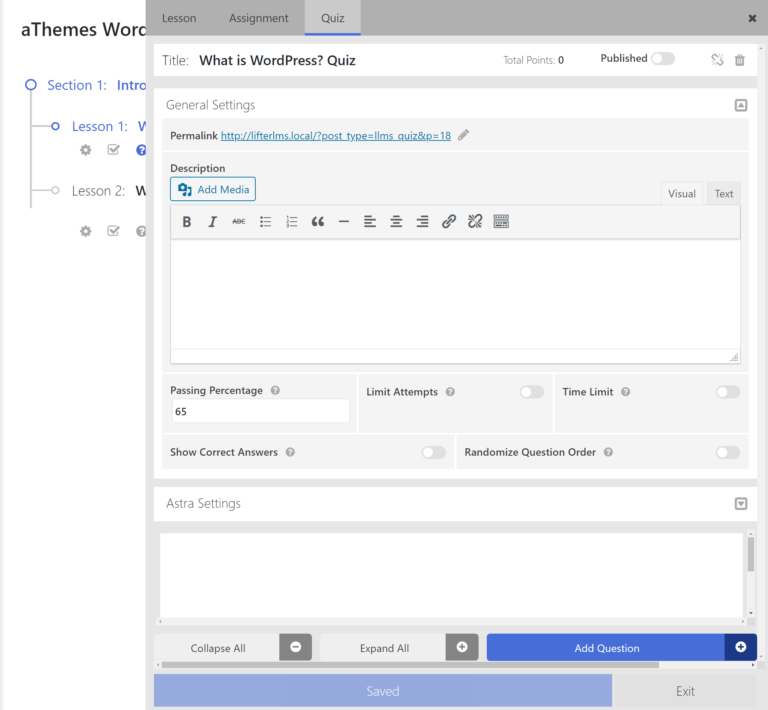
Then, you can add questions.
With the free version, you only get the following questions:
- Multiple choice (either choose a single answer or choose multiple answers)
- Picture choice
- True or false
To unlock all of the advanced questions, you’ll need a pricey add-on (more on pricing later):
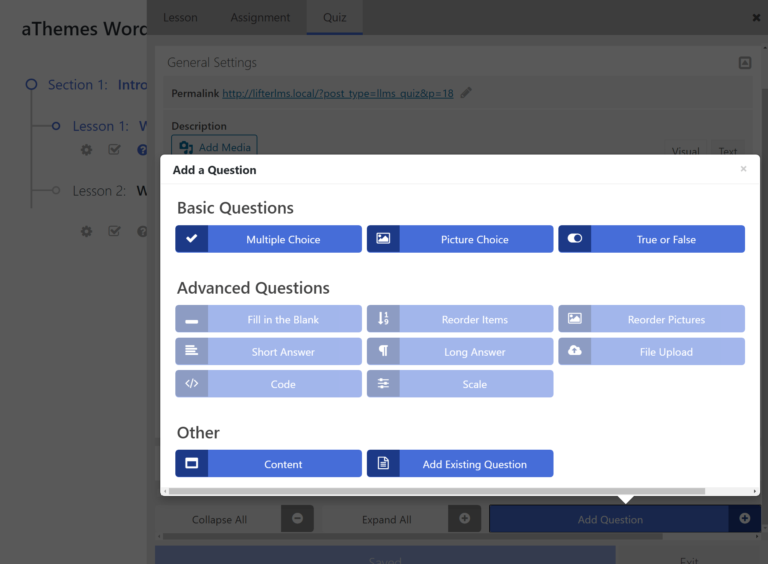
How You Can Charge for Courses
Both LifterLMS and LearnDash include multiple options for charging for access to your courses:
- You can use the plugin’s built-in payment feature and connect directly to payment gateways such as Stripe.
- You can integrate with WooCommerce to use it to handle payments. This lets you take advantage of WooCommerce’s flexible coupons, as well as other WooCommerce extensions.
They also give you a good deal of flexibility for how you charge. For example, you can sell individual courses, groups of courses (bundles), group memberships, and more. You can also go with one-time payments or recurring subscriptions.
Overall, I would say that LifterLMS is a little more flexible than LearnDash, especially when it comes to the more “membership site” aspects of selling online courses.
However, both should be flexible enough to handle most situations.
Charging for LearnDash Courses
If you want the most flexibility for charging for LearnDash courses, you’ll probably want to use the WooCommerce add-on, rather than the built-in payments functionality.
Still, for basic uses, the built-in LearnDash payments feature works fine.
When you edit a course, you can choose different methods of access:
- Open – anyone can take the course, no registration required.
- Free – the course is free, but people must register to take it.
- Buy Now – people need to pay a one-time fee to take the course.
- Recurring – people need to pay a recurring fee to take the course.
- Closed – use this if you’re using a separate integration (such as WooCommerce).
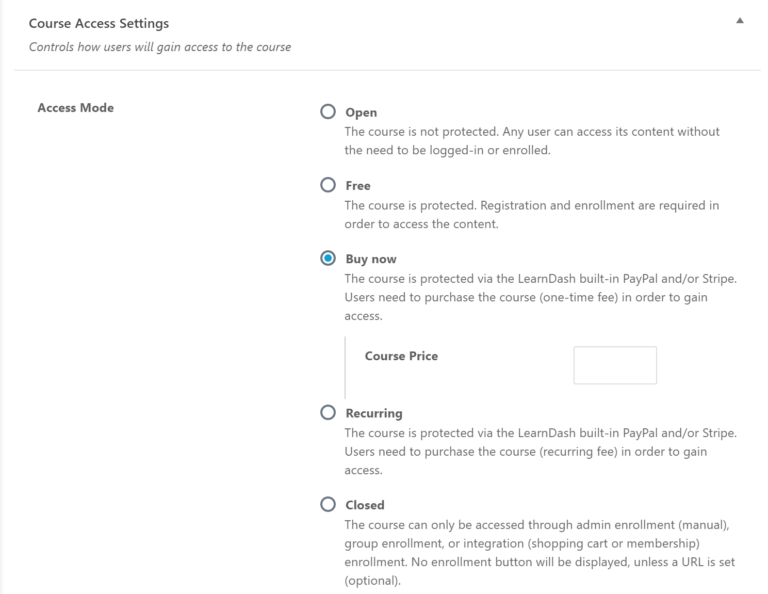
LearnDash also lets you create user groups that give all of the users access to one or more courses. You could use this to sell institutional access. For example, if you have a certification course, you could sell a group membership to a business that wants to get all of their employees certified:
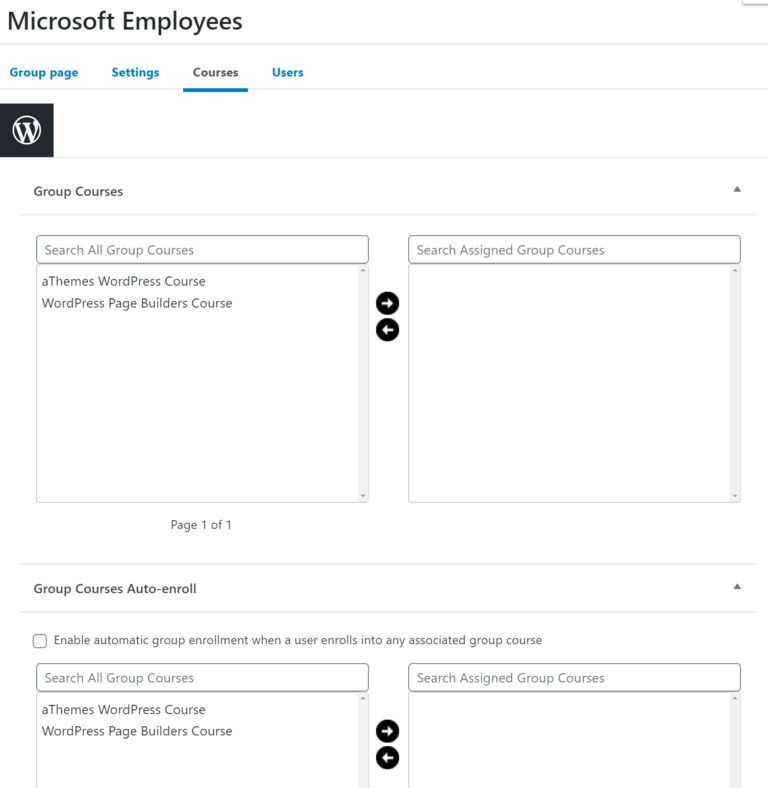
For group memberships, you’ll get all the same payment settings as individual courses.
Again, in some situations, this might be all you need and the built-in payment settings are super easy to use. But if you want more flexibility, you’ll want to integrate LearnDash with WooCommerce.
With the WooCommerce extension, you’ll be able to associate one or more courses with WooCommerce products. This lets you:
- Sell bundles of courses.
- Offer sales and coupons to entice people to sign up.
With the extension, you’ll get a new Course product type in WooCommerce. You can link the product to give access to one or more courses or groups:
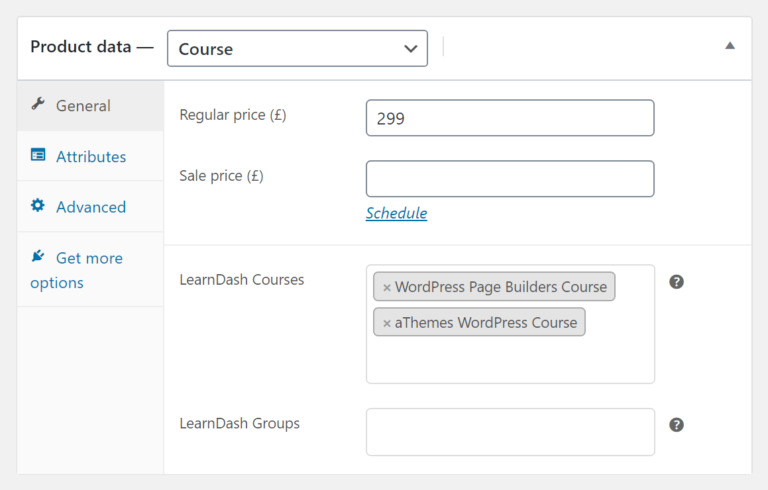
If you want to sell recurring subscriptions with the WooCommerce method, you’ll need to purchase the separate WooCommerce Subscriptions plugin, though, which can get a little pricey.
By using WooCommerce, you can also pair LearnDash with something like CartFlows to create sales funnels with order bumps and upsells, which can be very effective for online courses.
Charging for LifterLMS Courses
LifterLMS is quite flexible when it comes to payments, even without integrating with WooCommerce (though it does offer a WooCommerce integration plugin).
To manage access to courses, you can create Access Plans, which are a lot more flexible than LearnDash’s native payments feature.
With an access plan, you can choose between lifetime or recurring payments. You can also use different recurring schedules and set a plan end time. For example, you could create a payment plan like “Pay $199 every month for 3 months for lifetime access”.
You can also set access expirations for both one-time and recurring plans. For example, you could charge a one-time $99 fee for six months of access.
Other useful features include:
- Trial offer – you can offer a free or paid trial that gives people access for a limited time.
- Sale pricing – you can run sales during specific dates.
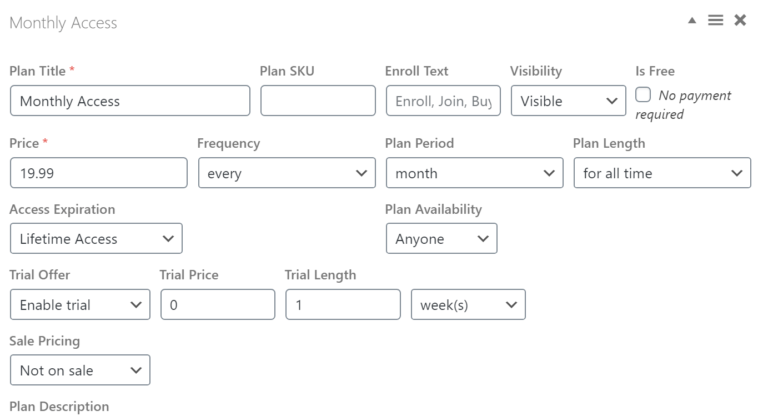
You also have the option to assign multiple access plans to a course. For example, you could offer both one-time payments and a payment plan for lifetime access:
- $499 one-time for lifetime access.
- $199 per month for three months for lifetime access.
Again, you can do this all without WooCommerce. So, as you can probably see, LifterLMS is definitely a lot more flexible than LearnDash, at least as far as built-in payment features go.
In addition to charging for individual courses, you can also create memberships.
With a membership, you can automatically give members access to one or more courses. You’ll also get all the same “Access” plan settings that you saw above for individual courses.
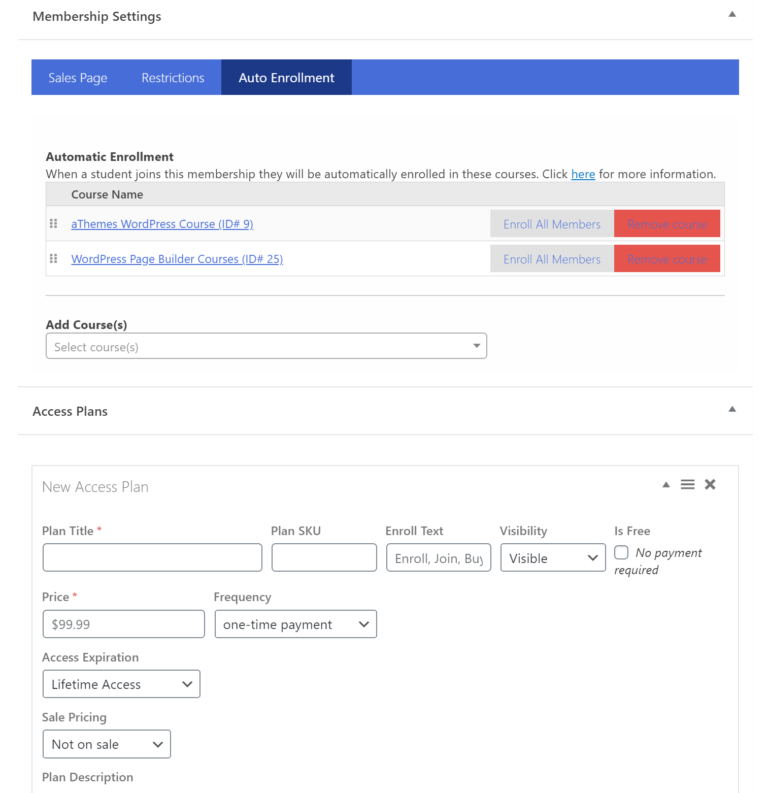
You can sell memberships directly to individuals. Or, with the paid LifterLMS Groups extension, you can sell memberships (and courses) to groups of users.
If you do want to use WooCommerce, LifterLMS also does have a WooCommerce integration, though.
LearnDash vs LifterLMS Pricing
When it comes to pricing, there’s no clear-cut winner on which plugin is more affordable.
Overall, LifterLMS has the potential to be the cheaper option. However, if you need access to lots of features, LearnDash can be a much more affordable option
To unpack why that is, we need to dig into the pricing.
First, there’s the obvious difference:
- LearnDash does not have a free version. It only comes in a premium version, which starts at $159. The premium version includes all of the features in one package — there are no separate extensions*.
- LifterLMS offers its core plugin for free at WordPress.org. Then, the developer sells tons of different add-ons, which you can either purchase individually or as a bundle. Individual add-ons are $99+ and the cheapest bundle is $299 per year.
*The cheapest tier doesn’t have LearnDash’s ProPanel feature, which is an advanced admin dashboard that really only applies to serious educational institutions (such as universities or schools).
How LifterLMS Can Be Cheaper Than LearnDash
The core LifterLMS plugin at WordPress.org has all of the features that most people will need to create courses. You’ll still get the drag-and-drop course builder, basic quizzes, etc.
So, for a “normal” online course, you probably only need the free version of LifterLMS for the course functionality.
What the free core version does not offer, though, is support for payment gateways. However, it does include all of the payment flexibility that you saw above — you just can’t hook those payment features up to an online payment gateway without an extension.
If you want to add payment support to LifterLMS, you’ll need to purchase at least one of the premium payment gateway extensions. LifterLMS offers extensions for:
- Stripe
- PayPal
- Authorize.net
- WooCommerce
These extensions cost $99 each.
If you want the cheapest way to launch paid only courses, this is how you do it:
- You use the free core LifterLMS plugin at WordPress.org to create and manage your course content.
- You purchase one payment gateway extension so that you can charge for access.
That means you’re paying $99 all-in for everything, which is cheaper than LearnDash’s starting price of $159.
How LearnDash Can Be Cheaper Than LifterLMS
You can probably see where this is going…
LifterLMS’s premium add-ons start at $99, with some going for $199.
So, if you need more than the single payment gateway add-on, LifterLMS can quickly become a lot more expensive than LearnDash.
Again, the free core LifterLMS plugin is quite generous, so most people will probably be fine with the free plugin as far as course functionality goes.
But if you need more course functionality and/or management features, LifterLMS gets expensive really fast.
Remember, LearnDash gives you pretty much every feature in its paid plans. Even with the entry-level LearnDash plan, you still get:
- Group management to place users into groups (and sell group access)
- Assignments
- Advanced quizzes
- PDF certificates
- And more
These features are pricey with LifterLMS.
For example, if you purchased individual LifterLMS extensions, you’d be looking at:
- Assignments – $199
- Advanced quizzes – $199
- Groups – $199
- PDFs – $199
You could save money by purchasing a bundle, but you’re still going to pay a lot more than you would with LearnDash.
Conclusion: Which Plugin Should You Choose?
LearnDash and LifterLMS are the two best WordPress LMS plugins, at least in my opinion, so I don’t think you’ll make a disastrous decision either way.
If you’re still not sure which to pick, here’s my recommendation:
To get started, install the free version of LifterLMS on a test site. Play around with it and create some course content. Basically, you want to see if the free version can do everything that you need it to as far as creating and organizing your courses. As I said earlier, I think that, for most people, the free version is powerful enough as it is.
If it can, then all you need to do is purchase one of the premium payment gateway extensions for $99 and you have a very affordable way to start selling premium course content on WordPress.
However, if you run into issues with limitations in the free version, then I think you should seriously consider LearnDash. For example, maybe you need more flexibility for quizzes or assignments, or maybe you need to place course takers into groups.
If you need these types of features, LearnDash is probably going to be a lot more affordable than LifterLMS.
The exact difference depends on the features you need, but it could be multiple hundreds of dollars. LearnDash is also a great product, so it’s tough to justify spending hundreds more on LifterLMS in that scenario.
And no matter which plugin you choose, check out our collection of the best LMS WordPress themes to set your courses up with a great-looking foundation.
Still have any questions about choosing between LifterLMS vs LearnDash? Ask away in the comments!
